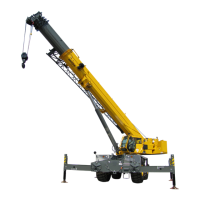NATIONAL CRANE Published 09-06-2019 Control # 691-01 2-15
NBT60L OPERATOR MANUAL SAFETY PRECAUTIONS
Refer to the above Lifting Limits at wind speed V(z)
>13.4m/s and ≤ 20.1 m/s. Comparing the load and wind
resistant area to the allowable:
• Is the load to be lifted less than allowable load?
8,000 kg ≤ 12,040 kg YES
• Is Awr
(load)
less than Awr
(allow)
?
19.83 m
2
≤ 14.45 m
2
NO
Conclusion: This load is NOT
permissible to lift in wind
speed up to 20.1 m/s, but permitted to lift at a reduced wind
speed calculated as follows:
Ratio = 1.37
From Table 2-5, the maximum permissible wind speed at
ratio of 1.37 (rounded to next higher table value of 1.4) is
17.0 m/s.
Conclusion: This load is permissible to lift in wind speed up
to 17.0 m/s only.
Table 2-6 Example-Capacity Reduction Factors for Wind Speed V(z) Greater than 30 mph - Non-metric
(Only for lifting with main boom on fully extended outriggers, with or without stowed extension)
For wind speed Vz (3-second gust speed at boom tip height) is greater > 30> mph ≤ 45 mph, the Reduced Capacity
shall be calculated by multiplying the Published Rated Capacity by the following factors:
Main Boom Length in Feet
Wind Speed
Vz> 30 mph
<
45 mph
36 40 50 60 70 80
90 100 110
Factor 0.9 0.9 0.8 0.8 0.8 0.8
0.8 0.7 0.5
Wind resistance area of load, Awr
(load)
, shall not exceed maximum allowable wind resistance area Awr
(allow).
Maximum allowable wind resistance area in [ft
2
],Awr
(allow)
= 0.0059 x calculated reduced capacity in lb.
Wind resistance area of load, Awr
(load)
= projected wind area Ap x wind drag coefficient Cd for the load.
For wind resistance area of load, Awr
(load)
> maximum allowable wind resistance, Awr
(allow),
refer to equipment
Operator Manual.

